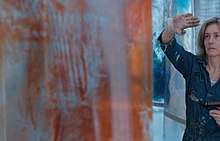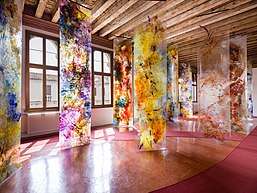Beverly Barkat
Beverly Barkat (born 1966) is an Israeli visual artist.

Early life and education
Beverly Barkat was born in 1966[1] in Johannesburg, South Africa to Louis and Lorna Sakalovsky, both artists themselves.[2][3][4][5] In 1976, the family immigrated to Israel.[5] She finished her studies at Bezalel Academy of Arts and Design in 1990,[6] earning a BFA from the Department of Metalsmithing and Jewellery Design.[5]
Art career
In 1995, Barkat worked in glass art in the Czech Republic and was invited to participate in an international glassblowing and sculpting symposium. From 2006 to 2009, Barkat studied painting in Israel Hershberg's Master Class at the Jerusalem Studio School. She took part in the JSS Summer Program in Italy twice, studying and participating in workshops alongside artists Lennart Anderson, Stuart Shils, and Raoul Middleman.[7] Barkat experimented with new materials and architectural spaces. She dedicated herself to architectural projects such as the building and renovation of private homes, as well as communal spaces and libraries in elementary schools to improve the educational climate. In 2009 Barkat opened her own studio in Jerusalem. Her works have been presented internationally, in group and solo exhibitions.[8]
Work
Barkat’s early paintings were largely figurative and in keeping with the traditional Western genres.[9]

Around 2009, her paintings took a turn towards formal abstraction, with influences of Cubism and Abstract Expressionism from her formative years becoming more apparent. Although she continued to draw from life, she started to deconstruct the figure and at the same time, capture movement on a two-dimensional surface with dynamic lines.[9] In 2014, her set of paintings were inspired by Japanese calligraphy. She was awarded the Curator's Award at the 28th International Exhibition of Art & Design in Kyoto, Japan.[10] Barkat started experimenting with new techniques, application methods and materials, the most prominent being the use of transparent PVC sheets as support for her paintings. These she paints in a manner reminiscent of action painting. Sally Haftel Naveh, the curator of her 2017 exhibition in Venice, comments on her use of this new material in the exhibition catalogue:
“The PVC sheets that Barkat picks for her paintings differ from other more conventional supports first and foremost in their transparency, so that while each side carries its own self-contained painterly motif, it echoes at the same time the one found overleaf. The work process progresses on both sides simultaneously, in constant symbiosis, free of any predetermined precepts or hierarchies.”[11] The centrepiece of her 2017 site-specific exhibition entitled Evocative Surfaces, supported by Outset Contemporary Art Fund[12] and exhibited at Palazzo Grimani in Venice, were 12 large PVCs hung from the ceiling. Their abstract and colourful surfaces interacted with the light and the architectural surroundings of the stately Venetian edifice.[13][14][15][16][17][18]

In 2018 Barkat held her second institutional exhibition in Italy, at Museo Boncompagni Ludovisi in Rome.[19][20][21][22] The exhibition, titled After the Tribes, was curated by Dr. Giorgia Calo, who explains in the exhibition catalogue:
"After the Tribes presents itself as a large abstract, three-dimensional trompe-l’œil that dialogues with the mural paintings of the tree-lined allées and gardens of Villa Ludovisia, painted on the walls of the Salone delle Vedute, where the installation is located. After the Tribes projects the spectator into another dimension, in which space is annulled and we find ourselves in an imaginary place, one that evokes a story reaching back across the millennia."[23]
Exhibition After the Tribes has been supported by Polo Museale del Lazio, Embassy of Israel in Italy and Nomas Foundation.[19]
 Model Series, Evocative Surfaces exhibition, Museo di Palazzo Grimani, Venice 2017
Model Series, Evocative Surfaces exhibition, Museo di Palazzo Grimani, Venice 2017 Beverly Barkat working in her studio, in Jerusalem.
Beverly Barkat working in her studio, in Jerusalem. After The Tribes exhibition, Museo Boncompagni Ludovisi, Rome 2018
After The Tribes exhibition, Museo Boncompagni Ludovisi, Rome 2018 After The Tribes exhibition, Museo Boncompagni Ludovisi, Rome 2018
After The Tribes exhibition, Museo Boncompagni Ludovisi, Rome 2018
Selected exhibitions
- N&N Aman Gallery, Tel Aviv, Israel 2013 N&N exhibition, curated by Naomi Aviv.
- Artists' House Tel Aviv, Israel, 2013 Screening Layers, curated by Smadar Sheffi.[24][25]
- International Community House, Kyoto, Japan, 2014 The International Art & Design Exhibition.
- Kyoto Art Museum, Kyoto, Japan, 2014 The 28th International Exhibition of Art & Design (Kyoto City International Foundation Curators' Award).[10]
- Luciano Benetton Collection, Tel Aviv, Israel, 2015 Imago Mundi Israel / One – Contemporary Artists from Israel, curated by Naomi Aviv.[26]
- Museo di Palazzo Grimani, Venice, Italy, 2017 Evocative Surfaces, curated by Sally Haftel Naveh.[1][27][28][29][30][31]
- Museo Boncompagni Ludovisi, Rome, Italy, 2018 After the Tribes, curated by Dr. Giorgia Calo.[19][20][21][22]
Personal life
Beverly Barkat is married to Nir Barkat, with whom she has three daughters.[1]
References
- Libsker, Ari (21 June 2017). בוורלי ברקת רוצה שתשכחו לרגע את בעלה, ראש עיריית ירושלים, ותתחילו להתמקד באמנות שלה [Beverly Barkat wants you to forget her husband, the mayor of Jerusalem, for a moment, and begin to focus on her art]. Calcalist (in Hebrew). Retrieved 2017-09-26.
- "Information Center for Israeli Art". The Israel Museum. Retrieved 2017-12-29.
- "MusEYEum Online Catalogue - Lorna Sakalovsky". MusEYEum, The College of Optometrists. Retrieved 2017-12-29.
- "Israeli Artists Visit Beth Shalom" (PDF). Hakol: 3. April 1994.
- Schneider, Moira (December 5, 2008). "Beverly Barkat - an SA-born girl" (PDF). South African Jewish Report. 12, nr. 46. p. 17. Retrieved 2017-12-29.
- Levin, Leah (November 20, 2008). "Beverly Hills, 2008". Mynet (in Hebrew). Retrieved 2017-12-30.
- "Master Class Gallery". The Jerusalem Studio School. 2009-11-04. Retrieved 2017-08-17.
- Haftel Naveh, Sally (2017). Beverly Barkat: Evocative Surfaces. Italy: Marsilio Editori. p. 117. ISBN 978-88-317-2802-7.
- Haftel Naveh, Sally (2017). Beverly Barkat: Evocative Surfaces. Italy: Marsilio Editori. pp. 21, 22, 24. ISBN 978-88-317-2802-7.
- "The 29th Kyoto Art Festival and International Exhibition of Art". Viewed from the Outside. Archived from the original on 2017-09-24. Retrieved 2017-08-17.
- Haftel Naveh, Sally (2017). Beverly Barkat: Evocative Surfaces. Italy: Marsilio Editori. p. 26. ISBN 978-88-317-2802-7.
- "Outset - Supported projects". Outset Contemporary Art Fund. Retrieved 2017-12-30.
- Braga, Sonia S. (May 31, 2017). "Beverly Barkat, Evocative Surfaces". Architectural Digest (in Italian). Retrieved 2017-09-26.
- Gillerman, Dana (May 21, 2017). "מי אמר שוונציה שוקעת? (Who said that Venice is sinking?)". Yedioth Ahronoth (in Hebrew). Retrieved 2017-09-26.
- Camodeca, Domenico (September 11, 2017). "Evocative Surfaces: mille cromature di emozioni [Evocative Surfaces: A thousand chromatic emotions]". Blasting News (in Italian). Retrieved 2017-09-26.
- Pagani, Angela (2017). "Beverly Barkat, Evocative Surfaces". Giornale Sentire (in Italian). Retrieved 2017-10-23.
- Sirlin, Deanna (2017). "Women in Venice". The Art Section. Retrieved 2017-10-23.
- Cole, Alison (May 17, 2017). "57th Venice Biennale Review - Riveting and Bewildering". The Arts Desk. Retrieved 2017-10-23.
- "The colors of the 12 tribes of Israel". www.ilgiornaledellarte.com. Retrieved 2019-03-04.
- "'After the Tribes' : Beverly Barkat, much more than the mayor's wife - In Jerusalem - Jerusalem Post". www.jpost.com. Retrieved 2019-03-04.
- "La torre di Beverly". AD (in Italian). 2018-10-11. Retrieved 2019-03-04.
- Toscano, Franca. "History and Identity" (PDF). Modern Painters. Retrieved 4 March 2019.
- Beverly Barkat: After the Tribes. Marsilio Editori. 2018. pp. 16–23. ISBN 978-88-317-7945-6.
- Davis, Barry (19 December 2013). "Gray is the new palette". The Jerusalem Post. Retrieved 2017-08-17.
- Sheffi, Smadar; Barkat, Beverly (2013). Screening Layers (in Hebrew and English). Tel Aviv: Bet ha-omanim ʻa. sh. Yosef Zaritsḳi. OCLC 894696419.
- Benetton, Luciano; Aviv, Naomi; Milo, Daniel S.; Ofrat, Gideon (2014). Israel/One. Contemporary artists from Israel. Treviso: Fabrica. pp. 84–85. ISBN 9788898764341.
- "Evocative Surfaces – Beverly Barkat". Palazzo Grimani. Retrieved 2017-08-17.
- Testino, Arianna (May 4, 2017). "Questione di superfici. Intervista a Beverly Barkat" [Surface issues. Interview with Beverly Barkat]. Artribune (in Italian). Retrieved 2017-09-26.
- Zanti, Igor (21 July 2017). "Beverly Barkat: Evocative Surfaces a Palazzo Grimani". Espoarte (in Italian). Retrieved 2017-09-26.
- Caccavo, Paolo (September 12, 2017). "Beverly Barkat: Evocative Surfaces arriva a Venezia, Palazzo Grimani" [Beverly Barkat: Evocative Surfaces arrive to Palazzo Grimani, Venice]. Design Lifestyle (in Italian). Retrieved 2017-10-23.
- Field, Marcus (May 15, 2017). "Venice Biennale 2017: 10 Best Fringe Events". Independent. Retrieved 2017-10-25.